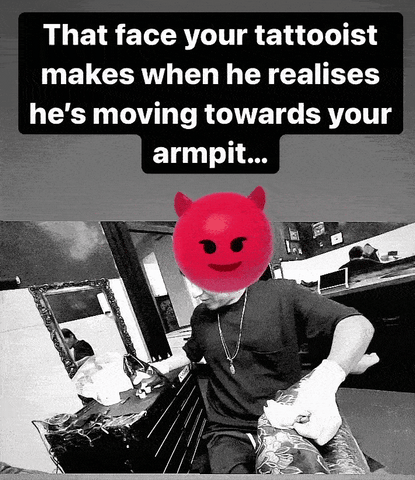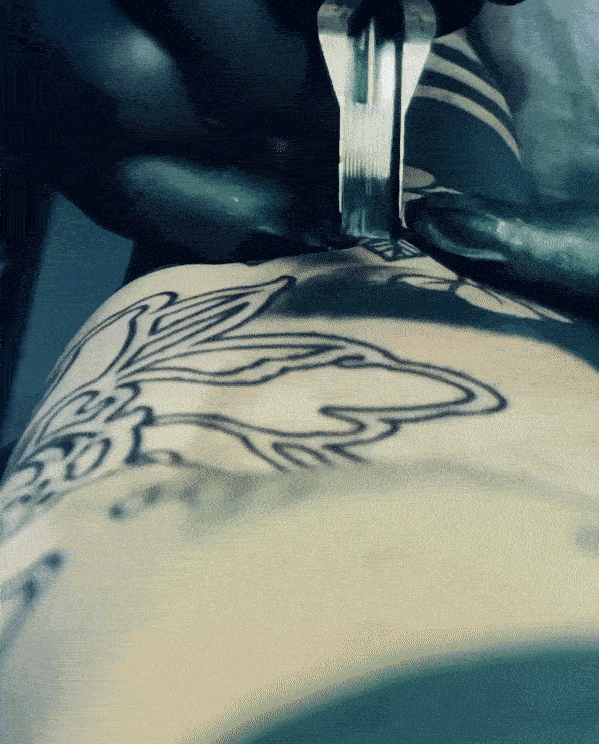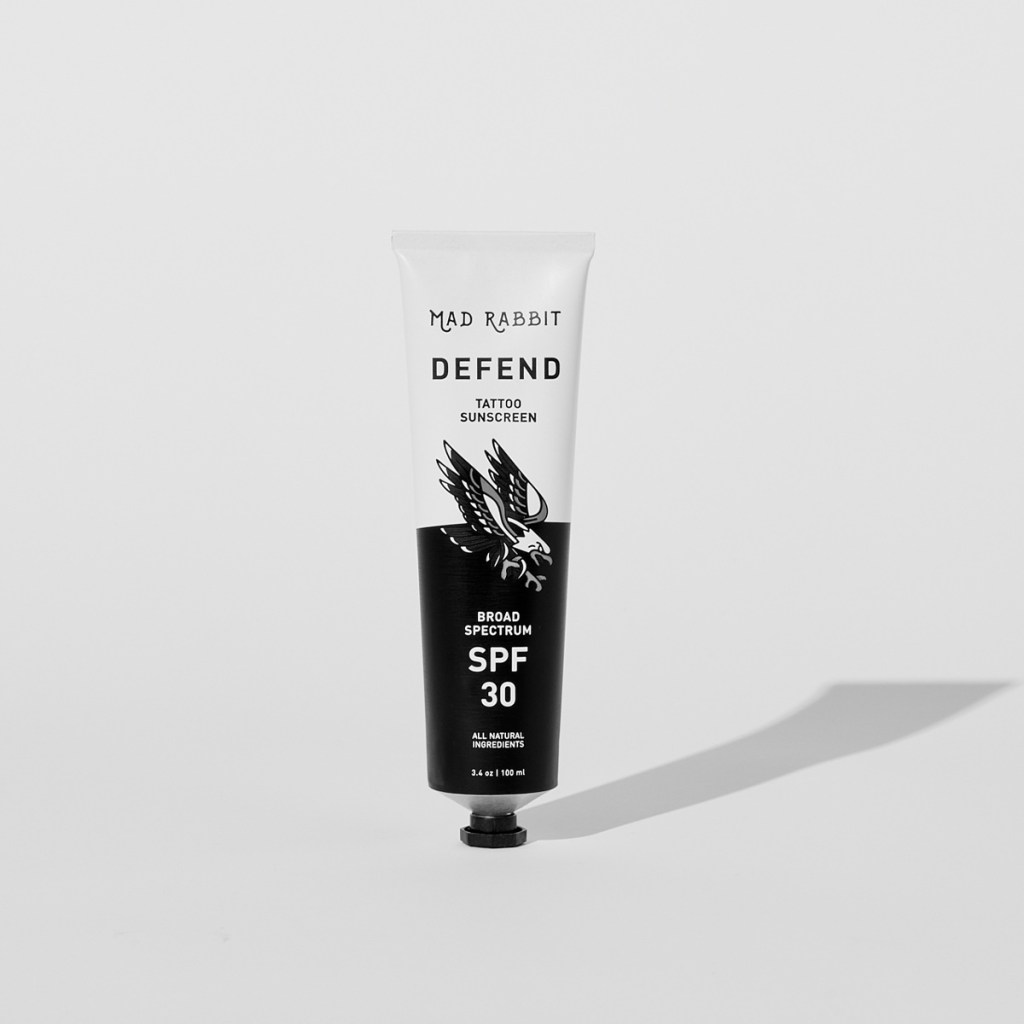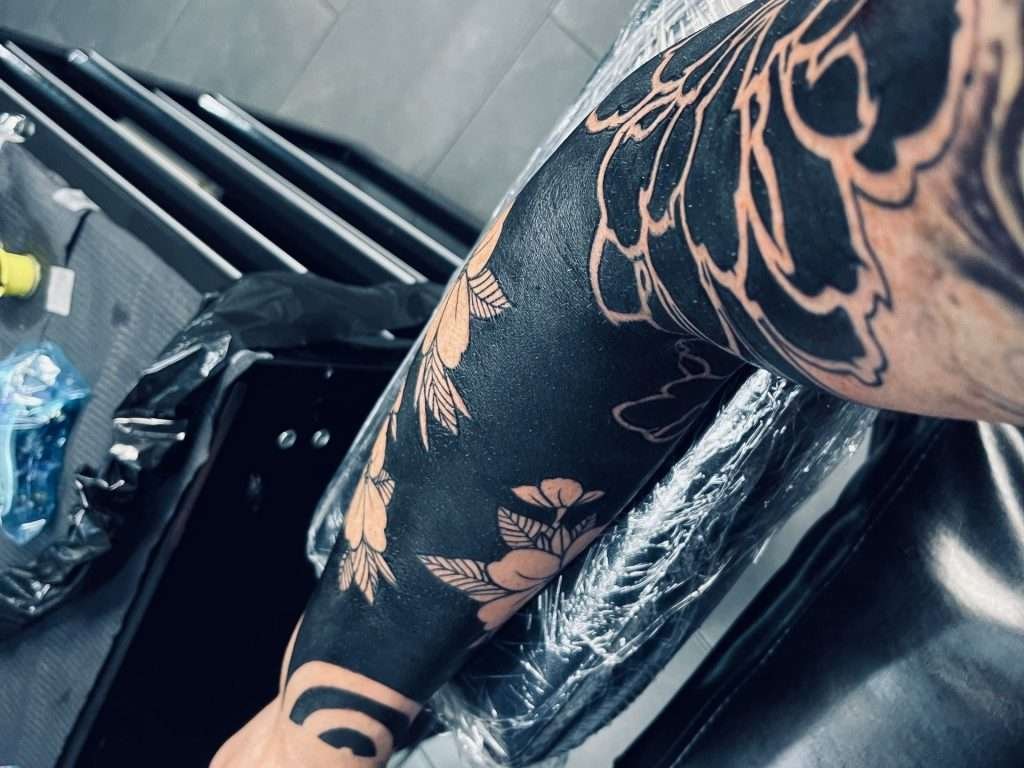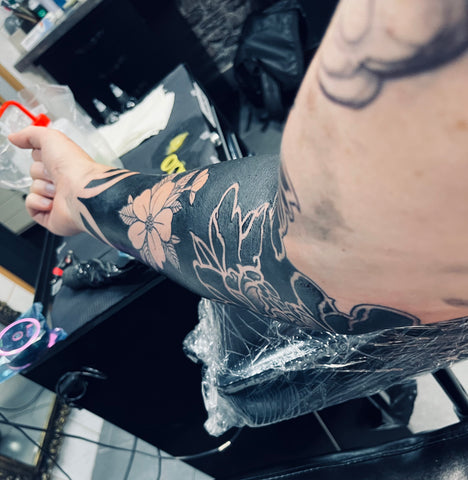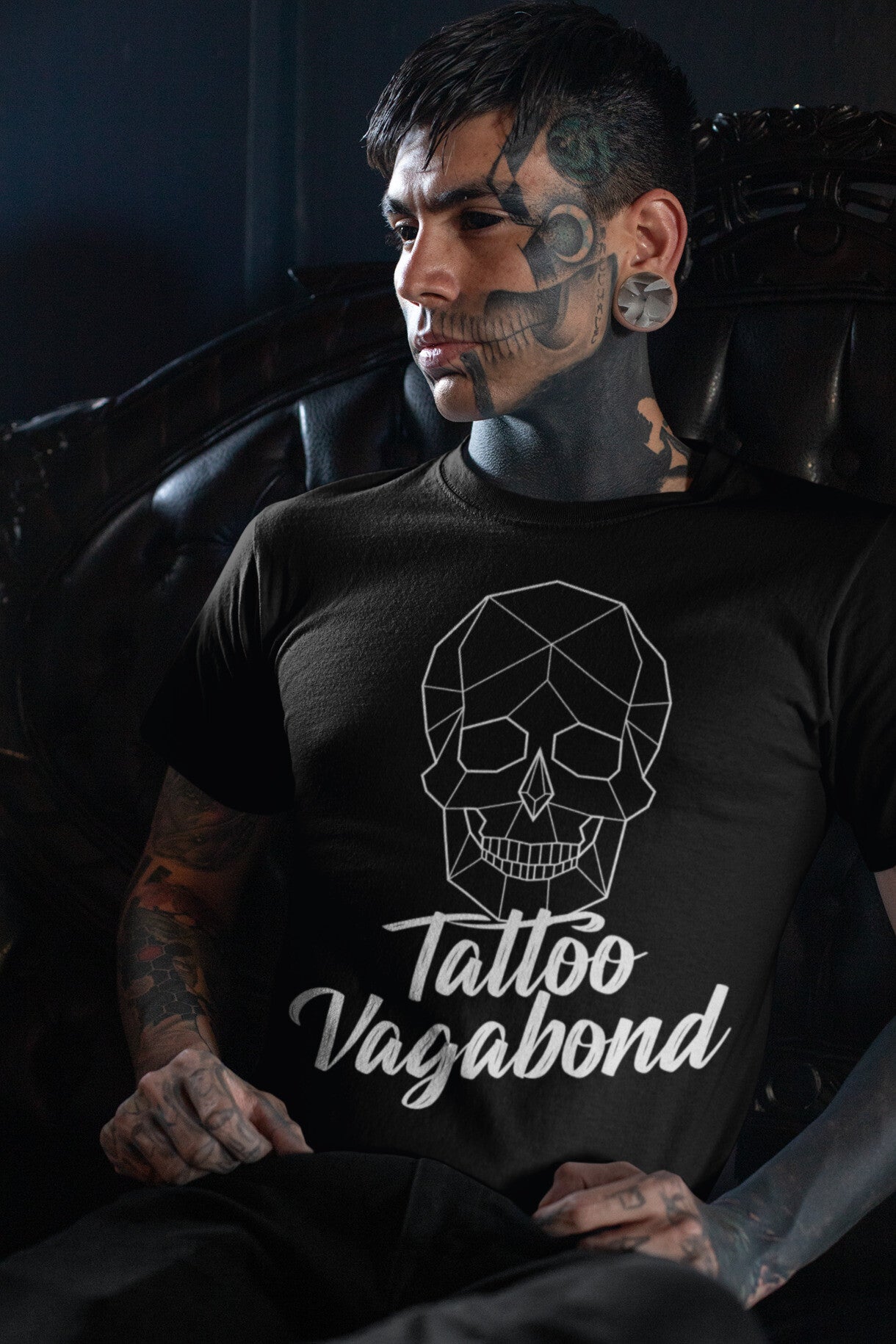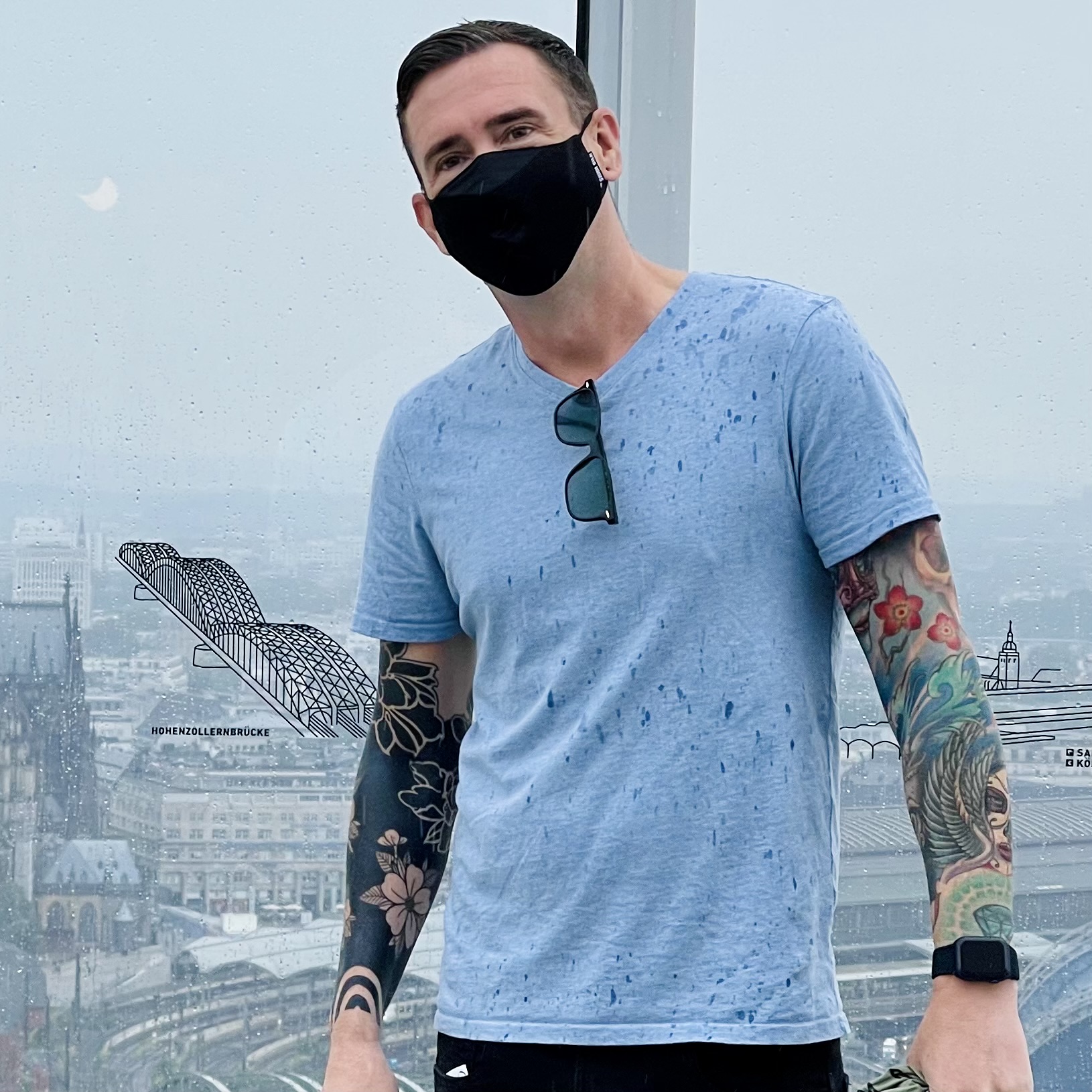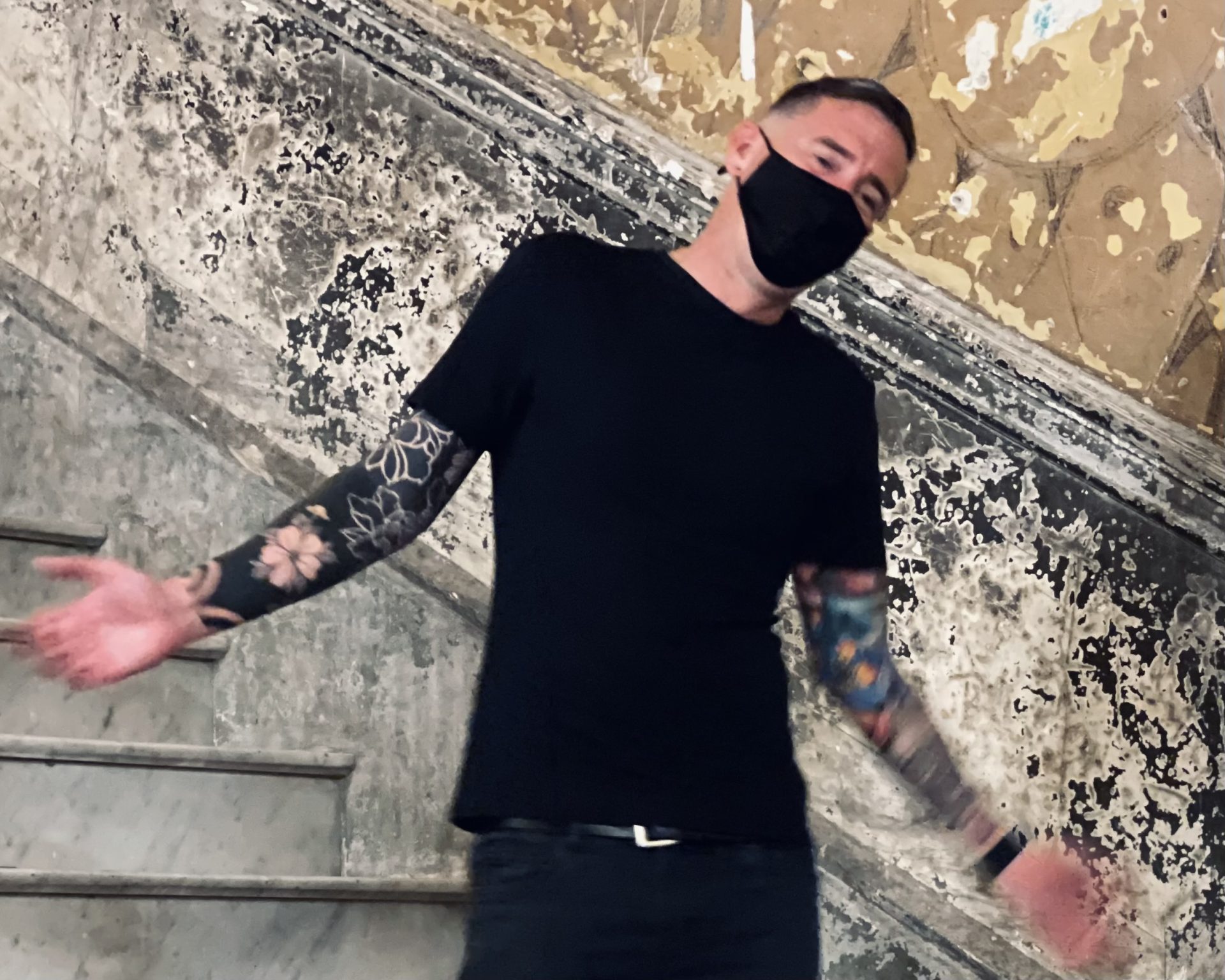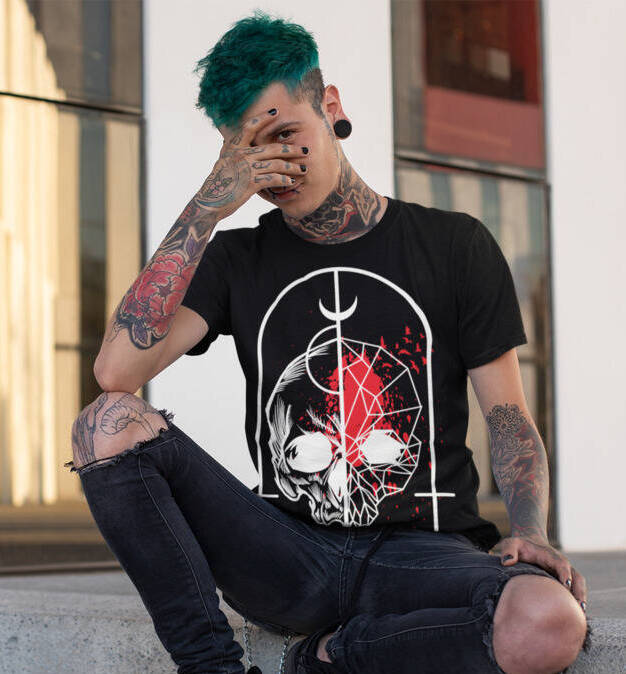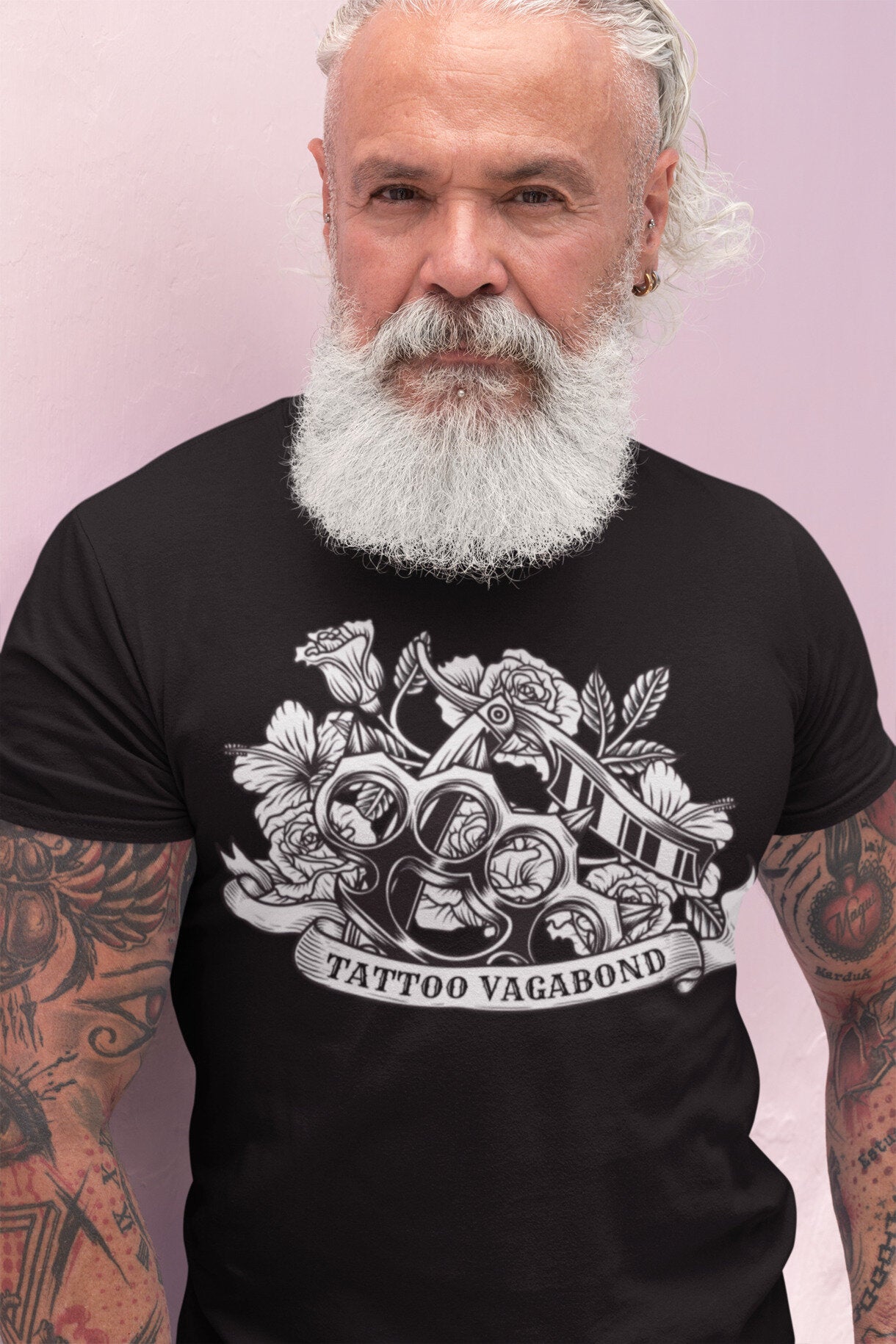Blackout tattoos, characterized by their distinctive feature of saturating the skin with intense black ink, pose a unique challenge in the tattoo world, both in terms of the experience and the healing process. The meticulous craft of creating a blackout tattoo often encompasses multiple sessions based on the client’s pain threshold, size of the design, and they come with a healing timeframe of 2 to 6 months.
As these tattoos become progressively popular, with many opting for them as cover-up solutions or to achieve a stark aesthetic contrast against the skin, it’s imperative to focus on blackout tattoo healing. I know from experience that understanding proper aftercare is crucial.
Proper blackout tattoo aftercare is about more than just preserving the art. It involves taking steps to support the skin’s recovery, minimizing pain, swelling and itching. All while preventing infection or scarring.
In this article, I’ll outline the top aftercare products that I’ve found pivotal for blackout tattoo healing and outline how to select the right ones to guarantee your heavy blackwork remains pristine. I will take you through each of the healing stages and delve into the blackout tattoo healing process, offering a careful review of aftercare items that I found useful when I got my own blackout sleeve.
Incorporating strategies for proper tattoo aftercare and highlighting common aftercare mistakes to avoid, this guide aims to be your go-to for maintaining the integrity of your blackout tattoos. After all, a meticulous approach to aftercare can dramatically enhance the outcome of your blackwork, and knowing when to start using pivotal products is essential!
How to heal your blackout tattoo – Based on my own personal experience!
Understanding Blackout Tattoos
Blackout tattoos are a bold form of body art where large areas, like the arms or legs, are covered with a dense layer of black ink. There’s many different forms and styles of blackout tattoos and they all fall within the domain of blackwork.
Here’s what I’ve learned about them while getting my own blackout tattoo sleeve:
- Aesthetic and Functionality: Their rise in popularity is fueled by their striking visual appeal on social media and their ability to function as a cover-up for previous tattoos. It’s a statement piece that turns heads and gives old tattoos a new lease on life.
- Time and Pain Investment: The process of getting a blackout tattoo is not for the faint of heart. It’s a marathon of multiple sittings, costing between $100 to $300 per hour, and the pain can be quite intense. This is a commitment of both time and pain tolerance.
- Healing and Health Considerations: Healing mirrors that of traditional tattoos, with an initial two-week healing period and up to six months for complete recovery. However, they come with additional health risks, such as the challenge of detecting skin conditions like melanoma due to the heavy ink coverage.
The cultural implications and the challenges of removal also stand out in my experience:
- Cultural Sensitivity: The conversation around blackout tattoos also treads into the territory of cultural sensitivity, particularly among people of color. It’s a nuanced subject that requires thoughtful consideration. Yet, blackout tattoos are not ‘cultural appropriation’.
- Removal Rigors: Should you decide to part ways with your blackout tattoo, be prepared for a removal process that’s more arduous and expensive than the original tattooing. Yet, black ink’s response to laser removal gives hope for those seeking to reverse their decision.
Lastly, the artistic perspective and practical challenges are noteworthy:
- Artistic Monotony vs. Transformation: For tattoo artists, the repetitive nature of inking solid black can be monotonous. Yet, projects like the Brutal Black Project highlight the transformative potential of this art form.
- Technical Challenges: Achieving full coverage over older tattoos can be tricky, and not all colors hide easily under the blackout veil. Additionally, the risk of infection, allergic reactions and scarring are present, as with any tattoo. But they may be heightened due to the extensive area covered in a blackout.
In my own journey to get a blackout sleeve, I’ve learnt that blackout tattoos are not just about making a bold statement. They’re about understanding the depth of commitment they require, from the intense application process to the intricate healing journey and the considerations for personal and cultural implications.
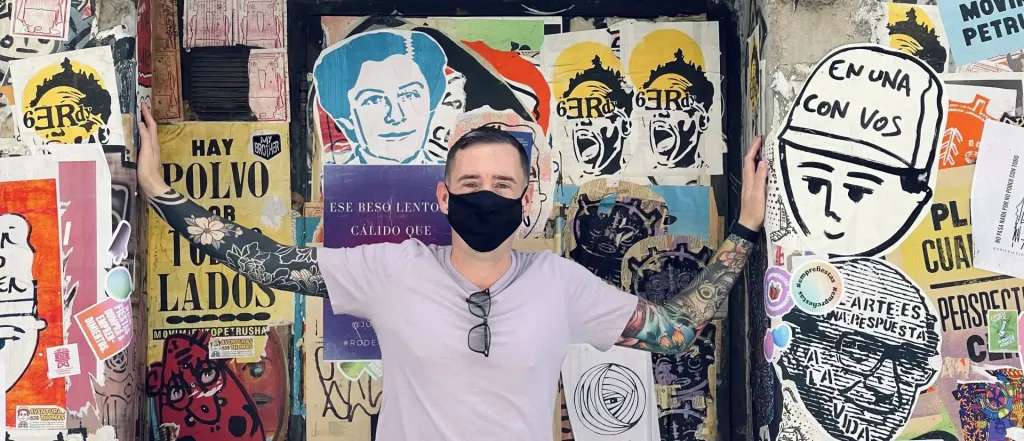
The Process of Getting a Blackout Tattoo
Getting a blackout tattoo is a deeply personal and intense experience. It’s one that requires an understanding of the technicalities and it requires you to prepare yourself for what lies ahead.
Here’s what I’ve learned about the blackout tattoo process:
- Equipment and Technique Mastery:
- A high stroke tattoo machine with a 4 to 4.2 stroke is vital. It’s designed to collect more pigment and deliver a harder hit, ensuring the dense blackness required for blackout tattoos.
- I’ve found that Straight Magnums with a 12 gauge diameter needle are the best choice. They create larger puncture holes, allowing for a faster ink flow and more efficient coverage.
- Consistency is the linchpin in blackout tattooing. The same depth, speed, passes, machine angle, and pressure must be maintained throughout to avoid patchiness or uneven healing.
- Ink Quality and Session Planning:
- Opting for a higher viscosity, thicker pigment is non-negotiable. It’s crucial to consistently check the pigment throughout the session to maintain the blackout tattoo’s uniformity.
- Blackout tattoos typically require multiple sessions. And it’s essential to plan out these sessions based on pain tolerance and the tattoo’s size. Being well-rested and prepared for back-to-back sessions is key to proper healing.
- Pain Management and Artist Selection:
- It’s no secret that blackout tattoos can be more painful than other designs, because of the artists ability to cover a much larger area per sitting than a more intricate design.
- Choosing an experienced artist specializing in heavy blackwork tattoos can make all the difference. Their expertise can lead to a smoother process and recovery, reducing the overall pain and healing time.
- Being prepared in advance for long tattoo sessions and arriving to the session with a tattoo numbing cream will enhance your experience. I tested dozens of different numbing creams on my own blackout sleeve and believe I’ve found the best tattoo numbing cream.
Before taking the plunge, I weigh the intensity of the process, the potential for skin trauma, and the challenges in detecting skin anomalies post-ink. I brace myself for the pain, the duration of the sessions, and the meticulous healing process that follows.
Swelling, post-session pain and peeling, are all part of the journey. But with the right aftercare, the result is a bold and beautiful blackout tattoo that stands the test of time.
Top Tattoo Aftercare Products for Blackout Tattoos
Navigating the aftercare of a blackout tattoo is as critical as the expertise and precision of your tattooist. I’ve come to rely on a select range of products that promote optimal healing, comfort, and that enhance the longevity of the dense blackwork.
Here’s a roundup of the top aftercare products that have earned my trust:
- For Fresh Ink (First 2 Weeks):
- Mad Rabbit REPAIR Soothing Gel: Infused with a powerful blend of anti-inflammatory, hydrating and anti-aging ingredients like aloe vera, chamomile and bisabolol, it effectively calms compromised skin and aids in the quick recovery of fresh ink.
- For Partially Healed Ink (2-4 weeks):
- Mad Rabbit ENHANCE Tattoo Balm Stick: Enriched with nourishing fatty acids, antioxidant-rich butters and lightweight oils, this all-natural formula promotes a healthy and vibrant appearance for your tattoos, while protecting your skin’s natural barrier against environmental stressors.
- For Healed Blackout Tattoos (After Week 4):
- Mad Rabbit REPLENISH Daily Tattoo Moisturizing Lotion: Enriched with nourishing plant oils, butters and plant-derived ceramides, this lotion effectively locks in moisture, revitalizing and replenishing your skin’s natural hydration levels. REPLENISH keeps your blackout tattoos looking a deep black!
In my experience, these products not only assist in the blackout tattoo healing process. But they also maintain the vibrancy of black tattoos and keep your blackouts looking a deep black. When selecting aftercare, I always ensure the product is free from irritants, aligns with my skin type, and is backed by positive reviews from both users and experts.
Remember, the key to a well-healed blackout tattoo lies not only in the quality of the ink and the skill of the artist. But also in your dedication to a rigorous aftercare routine using the right products!
How to Choose the Right Tattoo Aftercare Products
Choosing the right aftercare product for your blackout tattoo healing is paramount to ensure a smooth recovery and maintain the vibrancy of your blackout tattoo. Here’s a straightforward guide to help you make an informed decision:
Initial Tattoo Healing Phase (First 2 Weeks)
- Natural Ingredients: Look for products containing aloe vera, chamomile, bisabolol in their formulas. These ingredients are known for their skin benefits and ease of absorption.
- Examples: Mad Rabbit REPAIR, Mad Rabbit ENHANCE
- Avoid Harmful Chemicals: Steer clear of petroleum-based products, which can hinder the skin’s ability to breathe. Never use petroleum based products and instead opt for natural ingredients.
- What to Avoid: Generic petroleum jelly, heavy mineral oils
- Tattoo Soaps: Until the outer layers of skin has fully healed, use a mild and non-irritating tattoo soap for cleaning.
- Product Picks: Mad Rabbit REFRESH

Post-Healing Maintenance – Long Term Blackout Tattoo Aftercare
- Lotions and Moisturizers: After the initial phase, switch to a fragrance-free, non-comedogenic lotion to keep the skin supple and the tattoo vibrant.
- Recommended Brands: Mad Rabbit, Richie Bulldog
- Sun Protection: Protect your tattoo from the sun’s rays with a broad-spectrum sunscreen, SPF 30 or higher, devoid of harsh chemicals. Never expose your new tattoo to direct sunlight.
- Sunscreen Selection: Mad Rabbit Defend Tattoo Sunscreen 30+
Ingredients to Look For In Tattoo Products
- Soothing: Aloe vera, chamomile, bisabolol, shea butter or witch hazel
- Moisturizing: Glycerin, panthenol, hyaluronic acid
- Antimicrobial/Antioxidant: Tea tree oil, vitamin E, green tea extract, peppermint oil
How To Choose Tattoo Aftercare Products & Brands
- Ingredient Transparency: Always check that the product lists its ingredients. If the list is missing, it’s safer to avoid that product.
- Brand Reputation: Ensure the product is from a reputable brand that’s known for dermatologically tested products that are intended for human use. And avoid white-labelled, mass produced, Chinese junk.
- Avoid Home Remedies: Home concoctions can be unpredictable and potentially harmful to your tattoo’s healing process.
Remember, the right aftercare products support you during the different tattoo healing stages and contributes to the long-term beauty of your blackout tattoos. By following these pointers, you can confidently select products that will aid in the blackout tattoo healing process, without compromising the health of your skin or the quality of your blackwork.
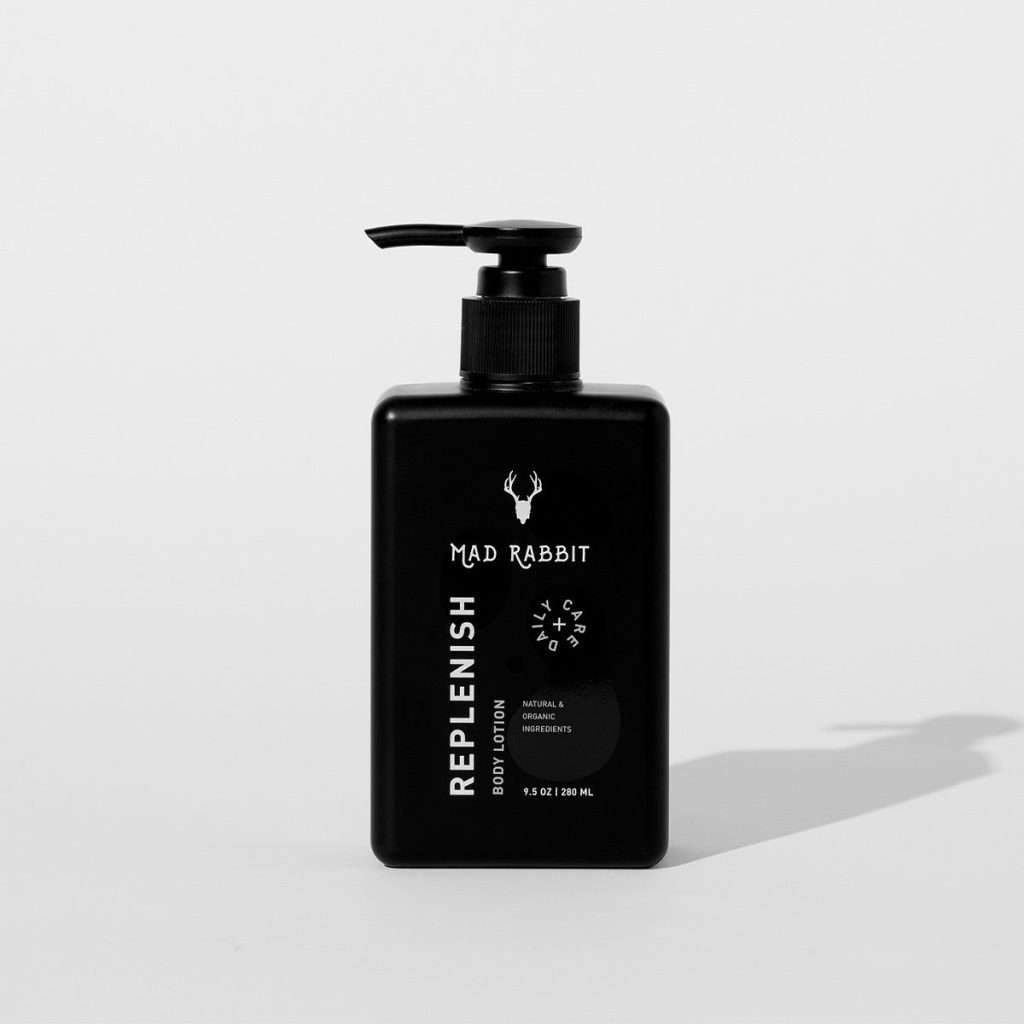
The Importance of Proper Tattoo Aftercare
Having gone through the process of healing my own blackout tattoo sleeve, I’ve come to understand the pivotal role of proper aftercare. It’s not just about preserving the artistry; it’s about safeguarding my skin’s health and ensuring that my blackwork remains as impactful as the day I was tattooed.
Here’s what I’ve learned about the importance of proper aftercare:
- Healing and Preservation:
- Rest and hydration are non-negotiables. They lay the foundation for optimal healing and ink preservation, allowing my skin to recover while maintaining my blackout tattoo’s intensity.
- Adhering to the artist’s instructions is paramount. They’ve seen it all and they know exactly what works best.
- Prevention of Complications:
- An infection or allergic reaction can turn a beautiful piece of art into a problematic one. Scarring can distort the blackout’s uniformity, which is why I take tattoo aftercare seriously. Infections and allergic reactions are a prime cause of ink drop.
- The initial aftercare steps are critical: keeping the artist’s dressing intact until you get home, gentle washing with fragrance-free soap, and applying the recommended ointment or lotion to kickstart the healing.
- Maintaining Tattoo Aesthetics:
- Moisturizing is key, especially with products free from fragrances and alcohol, to quell itching and promote healing. I found products with aloe vera most useful in stopping my own blackout sleeve from itching.
- I avoid sun exposure, swimming, and tight clothing during the healing process. These can lead to complications and damage to your new ink. And I want nothing to come between me and a well-healed tattoo.
Through my own experience, I’ve also learned to be vigilant for signs of improper healing, such as fever, chills or oozing liquid. These symptoms signal that it’s time to seek medical attention!
The blackout tattoo healing process is a testament to patience, with the surface of the skin taking up to two weeks to heal and the dermis up to six months. By consulting with skilled tattoo artists who are specialized in blackwork and following their aftercare instructions meticulously, I ensured that my own blackout tattoo experience was nothing short of successful.
And, as I continue on my own tattoo journey, I’m reminded of the long-term commitment to aftercare: regular washing with gentle cleansers, diligent moisturizing and applying sunscreen to protect the tattoo when I’m outdoors. It’s these steps that keep my own tattoo sleeves looking vibrant and my skin healthy.
Common Tattoo Aftercare Mistakes to Avoid
In my quest for blackout tattoo healing, I’ve encountered numerous pitfalls that can set back recovery and compromise the aesthetic of heavy blackwork tattoos. And that can cause infection and ink drop.
Here are some common aftercare mistakes to avoid:
- Wrap and Unwrap with Care:
- Improper wrapping or unhygienic removal can invite bacteria into the wound, heightening infection risks. Always follow your tattoo artist’s guidance on when to remove the wrap.
- If the wrapping is stuck to the tattoo, don’t panic and don’t try to just peel it off. Hop into the shower with the wrapping on and use the water to loosen it.
- Cleanliness is Key:
- Failing to clean the tattoo frequently can also lead to infection. It’s essential to clean your tattoo regularly using a tattoo soap and water, for proper tattoo healing.
- Moisturize Mindfully:
- Over-moisturizing may lead to clogged pores and breakouts, disrupting the tattoo healing process. Apply a thin layer of aftercare product multiple times per day, or as directed.
- Physical Activity:
- Exercising too soon can introduce bacteria and cause damage. Wait until you’re through the initial 2 week tattoo healing cycle to resume workouts.
- Water Woes:
- Avoid submerging your tattoo in pools, lakes, ponds or jacuzzis. Because dirty water can cause tattoo infections. Limit your tattoos exposure during showers to prevent water damage.
- Shower Sensibly:
- Excessive water exposure during showering can harm the tattoo. Keep showers brief and avoid direct streams of water on the new ink.
- Sun Safety:
- Direct sunlight can dry out and damage your new tattoo. Protect your black tattoos by covering them or using a high SPF sunscreen once healed.
- Scab and Scratch:
- Picking at scabs or scratching can distort the tattoo’s appearance. Let any scabs fall off naturally to avoid scarring and ‘ink drop‘.
- Sleep Smart:
- Sleeping without proper protection can expose your new tattoo to germs. Keep the area clean and covered as instructed. Also, be aware that your new tattoo will leak ink for the first week and cause ink stains.
- Avoid Smoking or Vaping:
- For the first two weeks after your tattoo session, you should avoid smoking and avoid vaping after a tattoo session. And that goes for smoking or vaping weed while your tattoo is in its critical first healing stage.
- Artist Expertise:
- An inexperienced tattoo artist might not consider individual skin differences, affecting ink placement. Research and choose a skilled tattooist who is specialized in blackwork.
- Covering Concerns:
- Keeping a tattoo covered too long can lead to blood and plasma build-up, blocking pores. Follow your artist’s advice on dressing duration.
- Product Pitfalls:
- Certain products can impede healing. Avoid astringents, antiseptics like TCP and Dettol, perfumed lotions, Sudocream, Vaseline, coconut oil, cocoa butter and sea shea butter. And don’t opt to ‘dry heal‘ a large blackwork.
As I experienced the tattoo healing stages with my own blackout sleeve, I learnt that vigilance and following expert advice is of paramount importance.
By steering clear of the common tattoo aftercare mistakes above, I made sure my own blackout tattoo healing process was on track for the best results. And 4 years on, my blackout sleeve still looks fresh.
Review of Tattoo Aftercare Products
I tried and tested several different aftercare products when healing my own blackout tattoo. And over the years running this website, I’ve come across a diverse range of options that cater to the specific needs of heavy blackwork tattoos. Yet, there’s only two that I would recommend.
Here’s a detailed examination of the two products that stood out for me, focusing on their efficacy, ingredients, and their suitability for the intense healing process that blackout tattoos require:
- Mad Rabbit REPAIR Tattoo Soothing Gel:
- Pros:
- Highly recommended by tattoo artists for its hydrating and anti-inflammatory properties.
- The ointment creates a protective barrier that supports the skin’s natural healing process.
- Aloe vera reduces the intense itching that’s experienced as a blackout heals.
- It has a very fast delivery.
- It offers great value for its price.
- Cons:
- For a large blackout tattoo, you will need multiple tubes.
- Needs to be ordered online and is rarely sold in supermarkets.
- Pros:
- Hustle Butter Deluxe Tattoo Butter:
- Pros:
- Contains natural ingredients like shea, mango, and peppermint oil.
- The product is free from parabens and synthetic fragrances.
- It’s a versatile product that can be used before, during, and after the tattooing process.
- Cons:
- Some users may find the texture too thick, which could lead to over-application.
- It’s on the pricier side compared to other aftercare products available on the market.
- Pros:
Both products have played a significant role in helping to heal my own blackout sleeve. Though the product that I used the most and that was the most beneficial throughout my own tattoo healing stages, was REPAIR by Mad Rabbit.
Both products will make a substantial difference in the healing process, and I encourage anyone with a heavy blackwork tattoo to consider these options carefully. Yet, in my experience the aloe vera in the REPAIR aftercare gel will be the most useful when the dreaded tattoo itch starts.
Remember, what works for one person’s blackout tattoo healing may not work for another. So, it’s important to listen to your own skin. And to choose the products that align with your body’s natural healing response.
When to Start Using Tattoo Aftercare Products
Timing is critical when introducing aftercare products to avoid disrupting the delicate healing stages of your blackout tattoo. Here’s a breakdown of when and how to start using aftercare products:
Initial Days Post-Tattooing (Day 0 to Day 2)
- Day of the Tattoo (Day 0): Keep the artist’s bandage on and avoid any aftercare products to allow the skin to start its natural healing process. Remove the bandage when you get home or as directed and then proceed to clean it and apply cream (below).
- When you get Home (Day 1): After removing the bandage, gently cleanse the tattoo with unscented antibacterial tattoo soap and warm water to prevent infection. Pat the area dry and apply your chosen aftercare product.
- Day 2-3: If you start to experience scabbing, increase your cleaning routine and be more vigilant with your application of aftercare products.
Transition to Fragrance-Free Lotions (Day 5-7 Onwards)
- Day 5-7: Once the tattoo stops oozing and the skin starts to turn flaky, slightly reduce your application of Mad Rabbit REPAIR Tattoo Soothing Gel and begin to transition to Mad Rabbit ENHANCE Tattoo Balm Stick.
- Day 7-14: Maintain a twice-daily moisturizing routine, using Mad Rabbit ENHANCE Tattoo Balm Stick to keeping the tattoo area clean and well-hydrated to support the peeling phase.
Post-Peeling Tattoo Care and Maintenance
- After Peeling: When the peeling stage concludes, it’s safe to moisturize with natural substances like argan oil or shea butter that promote skin elasticity and ink vibrancy.
- Continued Care: Continue to use clean towels, bedding, and clothes to protect the tattoo. Showering is permitted, but avoid soaking the area and shield the tattoo from direct sunlight for at least two weeks, applying a high SPF sunblock thereafter.
- Wearing Appropriate Clothing: Opt for loose, breathable cotton clothing to prevent irritation and allow the tattoo to heal without constriction.
By following these guidelines, I ensured that my own blackout tattoo healed perfectly and without complications. It’s a commitment to aftercare that pays dividends in the longevity and vibrancy of my own blackout tattoo.
Blackout Tattoo Aftercare Conclusions
The significance of a meticulous aftercare routine for blackout tattoos can’t be overstated. The process of getting a large blackwork takes a heavy toll on your skin. And you need to thoroughly heal after each session, if you want your blackout to stay a deep black for the years to come.
Healing and maintenance are critical with all styles of blackwork, not just blackouts. From my own experience of the process I can say with confidence that it’s evident that the choices we make in aftercare products and practices are pivotal in ensuring the beauty and health of both the tattoo and the skin it adorns.
Maintaining the allure of such a bold expression of body art is as much about commitment as it is about care—a notion that holds true well beyond the initial healing phase. It’s critically important that you adhere to a stringent aftercare routine and be conscious of the need for regular skin hydration and diligent protection from the elements!
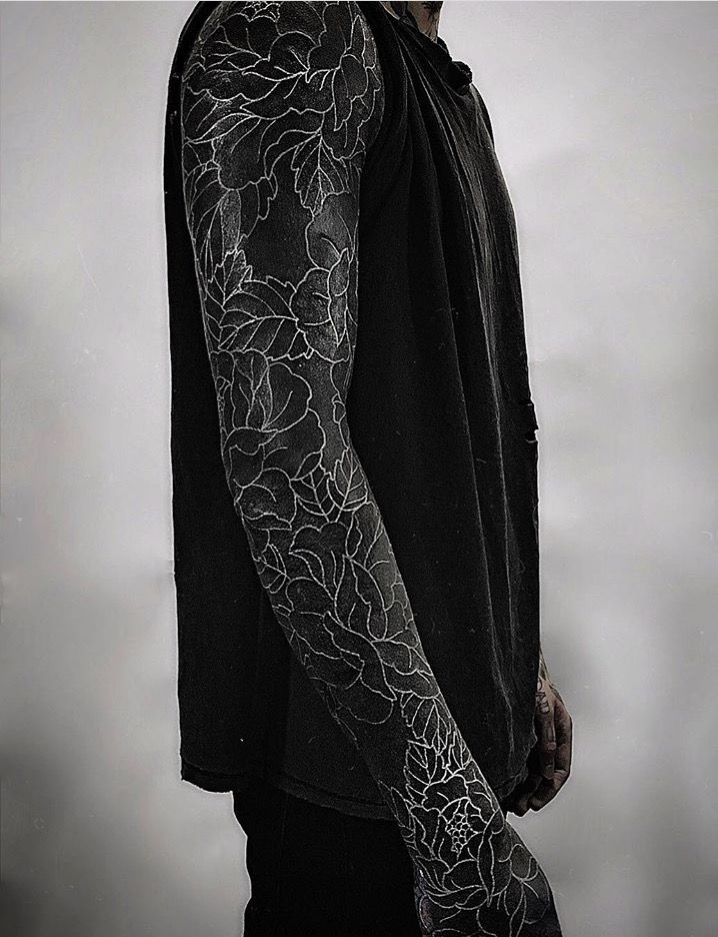

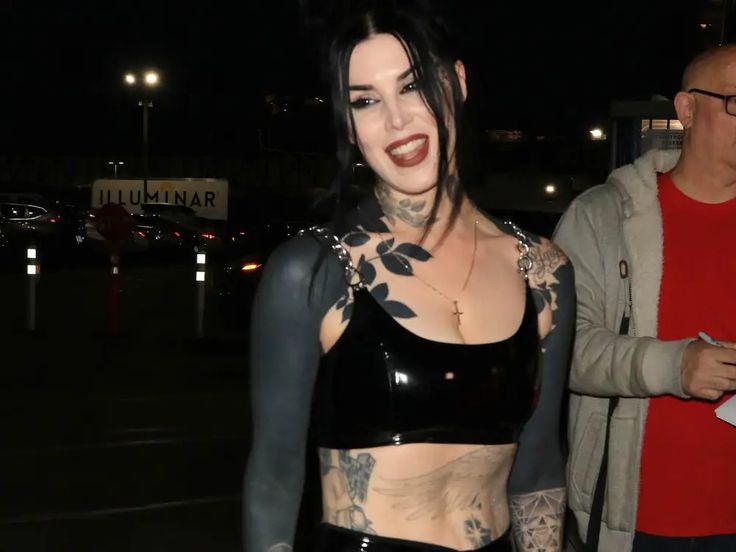
FAQs
What is the recommended timing for moisturizing a blackout tattoo?
After removing the cling film, as advised by your tattoo artist, you should thoroughly clean your new tattoo and begin applying your chosen aftercare products. Do not use generic scented supermarket moisturizers until the outer layer of skin is healed. And this usually takes about 2 weeks.
What steps should I follow to care for my blackwork tattoo?
You should never let a large blackout tattoo dry out or attempt to ‘dry heal‘. Excessive scabbing and cracking, caused by a large blackwork drying out, will lead to ‘ink drop‘ and cause a patchy appearance. You will then need a touchup session.
Always clean your tattoo and reapply your chosen tattoo aftercare product at least twice per day. Do not rewrap your tattoo at any stage during the healing process. Once you’ve removed the plastic wrapping as directed by your tattooist, leave it off.
Is peeling a common occurrence with blackout tattoos?
Yes, peeling is a normal part of the healing process for blackout tattoos. While the healing is similar to that of regular tattoos, blackout tattoos may have a slightly lower risk of allergic reactions, but a higher risk of tattoo infections and scarring. Increased pain and peeling may occur due to the extensive amount of ink in the skin, but the tattoo should heal within a few weeks.
Note: It’s common for blackout tattoos to seep ink, for the first few days. And this is due to the amount of ink packed into the skin during the tattoo process. Use only old clothes and bed sheets to avoid ink stains.
What is the best way to heal a blackout tattoo?
The best way to heal a blackout tattoo is to diligently follow all aftercare instructions. If you can’t commit to tattoo aftercare, you should rethink your decision to get a blackout tattoo.
Note: You should never attempt to dry heal a blackout tattoo or any large blackwork.
How much time does it typically take for blackwork tattoos to heal?
On the surface, blackout tattoos generally take about two to four weeks to heal. However, the full healing process, including the internal healing of the skin, can take anywhere from three to six months.
Initially, there may be a week of redness and oozing, followed by two to three weeks of itching and peeling. After approximately a month, the skin continues to heal from the inside.
Do blackout tattoos take longer to heal?
The bigger a tattoo is, the longer it takes to heal. During a tattoo session on a blackwork or blackout, the tattooist will cover a larger bodily surface area. And during your blackout session, the tattooist will pack more ink under the skin.
Because your blackout is larger, you can expect it to take slightly longer to heal than a tattoo of a different style. But a blackout tattoo will take only slightly longer to heal than a tattoo of a different style.
Do blackout tattoos need touch ups?
Whether or not your blackout tattoo requires a touchup will come down to 3 primary factors. Those factors are the skill of your artist, the ink used and your aftercare routine.
If your tattooist is skilled in blackwork and knows what they’re doing, and uses quality inks, then as long as you follow the recommended aftercare routine and look after your blackout tattoo, you shouldn’t require a touch-up.
Note: If you are using a skilled blackwork artist from a reputable shop, they will often provided touch-ups free of charge.
Are blackout tattoos bad for you? Or are blackout tattoos dangerous?
Blackout tattoos are not inherently bad for you and they aren’t dangerous. Blackout tattoos are safe, provided they are applied by a qualified tattooist following standard sterilization and safety protocols and using regulated inks.
Black is one of the safest colors of tattoo ink. And black is the least likely to cause an allergic reaction. It’s also one of the easiest colors for laser removal technologies to breakdown and remove.
Yet, when considering tattoo safety the primary factor is the artist whom you choose to get your tattoo from. A skilled profession blackwork artist knows which inks to use and they follow all sterilization and safety protocols.
Note: Never choose a tattoo based solely on price. And never get a tattoo from an unlicensed and untrained ‘scratcher‘.
Can I use a tattoo numbing product on my blackout tattoo?
I tested several tattoo numbing products when I got my own blackout sleeve. And I recommend using a tattoo numbing cream when getting a blackout.
If you have some tattoo numbing cream left over after your tattoo session, it’s best not to use it during the healing stages. If your tattoo itches and you wish to ease the itching sensation, use Mad Rabbit REPAIR Tattoo Soothing Gel with aloe vera.
My blackout tattoo is itching like crazy, is that normal?
All tattoos get itchy as they heal. Itching is perfectly normal. Yet the bigger the tattoo, the more it itches. And large blackwork tattoos will feel extremely itchy. Do not pick or scratch the tattoo.
You should keep your fingernails short during the healing process to ensure you don’t scratch the tattoo in your sleep. You should also use a tattoo aftercare product with an anti-itch formula, like Mad Rabbit REPAIR Tattoo Soothing Gel with aloe vera.
Who is the tattoo artist who did my blackout tattoo?
My tattooist is a Peruvian, who is now living and working in Germany. I first met him in Peru as a ‘tattoo tourist‘ and I now regularly travel to him in Germany.
My artist is jdavila_artblack on Instagram.
